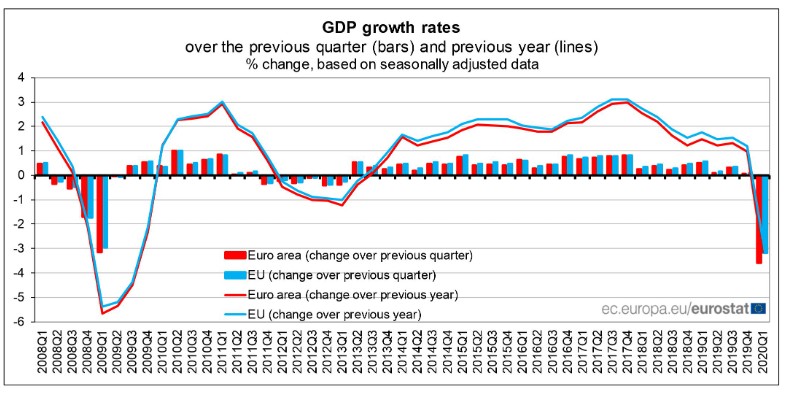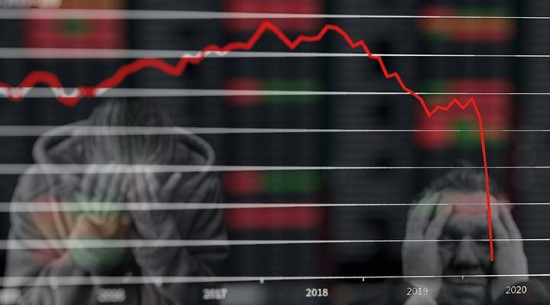Seasonally adjusted GDP decreased by 3.6% in the euro area and by 3.2% in the EU during the first quarter of 2020, compared with the previous quarter, according to an estimate published by Eurostat, the statistical office of the European Union. These were the sharpest declines observed since time series started in 1995.
In March 2020, the final month of the period covered, COVID-19 containment measures began to be widely introduced by Member States. In the fourth quarter of 2019, GDP had grown by 0.1% in both the euro area and the EU.
Compared with the same quarter of the previous year, seasonally adjusted GDP decreased by 3.1% in the euro area and by 2.6% in the EU in the first quarter of 2020, after +1.0% and +1.2% respectively in the previous quarter. These were the sharpest declines since the third quarter of 2009 (-4.5% for euro area and -4.4% for EU).
During the first quarter of 2020, GDP in the United States decreased by 1.3% compared with the previous quarter (after +0.5% in the fourth quarter of 2019). Compared with the same quarter of the previous year, GDP increased by 0.3% (after +2.3% in the previous quarter).
Among Member States for which data are available for the first quarter of 2020, Ireland (+1.2%), Bulgaria and Romania (both +0.3%) as well as Sweden (+0.1%) still recorded postitive growth compared with the previous quarter, while GDP fell in all other EU Member states, with the highest declines in France and Italy (both -5.3%) as well as Spain and Slovakia (both -5.2%).

Employment growth in the euro area and EU
The number of persons employed decreased by 0.2% in the euro area and by 0.1% in the EU in the first quarter of 2020 compared with the previous quarter. This is the first decline in the time series since the second quarter of 2013 for the euro area and the first quarter of 2013 for the EU. In the fourth quarter of 2019, employment increased by 0.3% in the euro area and by 0.2% in the EU.
Compared with the same quarter of the previous year, employment increased by 0.4% in both the euro area and the EU in the first quarter of 2020 (after +1.1% and +1.0% respectively in the fourth quarter of 2019).
Employment growth in Member States
In the first quarter of 2020, Lithuania (+1.6%), Malta (+1.3%) and Croatia (+1.0%) recorded the highest growth compared with the previous quarter. The largest decreases were observed in Spain (-1.0%), Bulgaria (-0.9%), Portugal, Slovakia and Sweden (all -0.5%).
At the level of industries, the sharpest declines were in agriculture (NACE A), (-1.4% in the euro area and -0.8% in the EU) in the first quarter of 2020 compared with the previous quarter. The information and communication sector (NACE J) had the strongest increases (+0.7% and +0.9% respectively).
Employment levels in the euro area and EU
Based on seasonally adjusted figures, Eurostat estimates that in the first quarter of 2020, 209.1 million people were employed in the EU, of which 160.4 million were in the euro area. In relation to the COVID-19 pandemic, employment in persons decreased by 0.3 million in the euro area and by 0.2 million in the EU compared with th fourth quarter of 2019.
While the effect of the COVID-19 pandemic on employment in persons was mitigated by government support schemes, the impact on hours worked is generally much more pronounced. The number of hours worked decreased by 3.1% in the euro area and by 2.6% in the EU in the first quarter of 2020, compared to the previous quarter.
Evolution of labour productivity in the euro area and EU
The combination of GDP and employment data allows an estimation of labour productivity. The analysis of growth compared to the same quarter of the previous years shows that productivity growth (based on employed persons) fluctuated around 1% for both zones between 2013 and 2018. In relation to the COVID-19 pandemic, there was a sharp decline in productivity in the first quarter of 2020 as GDP dropped sharply while the impact on employment in persons was still limited.
Geographical information
The euro area (EA19) includes Belgium, Germany, Estonia, Ireland, Greece, Spain, France, Italy, Cyprus, Latvia, Lithuania, Luxembourg, Malta, the Netherlands, Austria, Portugal, Slovenia, Slovakia and Finland.
The European Union (EU27) includes Belgium, Bulgaria, Czechia, Denmark, Germany, Estonia, Ireland, Greece, Spain, France, Croatia, Italy, Cyprus, Latvia, Lithuania, Luxembourg, Hungary, Malta, the Netherlands, Austria, Poland, Portugal, Romania, Slovenia, Slovakia, Finland and Sweden.





















